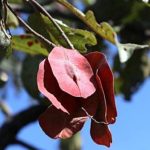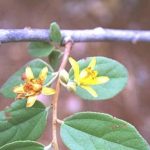TREE LIFE
July 2000
SUBS ($120) WERE DUE ON 1ST APRIL. A RED FACE ON YOUR LABEL IS A REMINDER THAT YOU HAVEN’T PAID AND THIS WILL BE THE LAST TREE LIFE THAT WE CAN SEND YOU.
WHILE THE PRESENT PROBLEMS PERSIST PLEASE CHECK WITH ANY OF THE COMMITTEE MEMBERS TO ENSURE THAT THE SCHEDULED OUTINGS AND WALKS WILL ACTUALLY TAKE PLACE.
MASHONALAND CALENDAR
Saturday 1 July. Botanic Garden Walk at 10.45 for 11 a.m. Tom continues with the very interesting topic ‘trees we rarely see’. We will meet Tom in the car park.
Sunday 16 July. Doug and Vida Siebert have kindly invited us to their property in Sentosa. This lovely garden and Ralph and Maia Chenaux-Repond’s property nearby will keep us happily occupied for the day. Bring your lunch and chair and enjoy a day in the sun. Meet at 9.30 a.m.
Saturday 22 July. Mark’s walk this month will be at Cleveland Dam. Meet in the car park at 2.30 p.m.
Saturday 5 August. Botanic Garden Walk.
MATABELELAND CALENDAR
Sunday 2nd July. Nothing planned for this month.
Sunday 6th August. Please phone Tessa Ball, Anthon Ellert or Jonathan Timberlake, for latest information.
BOTANIC GARDEN WALK: SATURDAY 6 MAY 2000
Today’s subject was “trees we rarely see” and it was an extremely exciting session as we moved from rarity to rarity – a botanical twitchers paradise.
Where did the rarities come from? Many were from the Haroni-Rusitu junction, that extraordinary area where the Haroni River meets the Rusitu River at the southern end of the Chimanimani Mountains. Here is moist low altitude (c.300 m) forest, quite unlike anywhere else in Zimbabwe and here are to be found a wide range of plants not found elsewhere. Other rarities came from the Chirinda Forest and two from the Honde Valley. The common factor generally was low to medium altitudes and forests. It is clear that a visit to the Haroni-Rusitu area is long overdue.
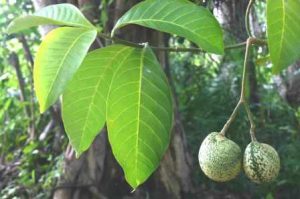
Voacanga africana . Photo: Bart Wursten. Source: Flora of Zimbabwe
To start with the Apocynaceae, we saw 3 of these. The family consists mainly of woody plants with (usually) opposite leaves in whorls of three and milky latex. The first species we looked at was Voacanga africana (Small-fruited Voacanga). In Zimbabwe, it occurs in fallow lands at the Haroni-Rusitu. It has cream-coloured flowers which Tom reports are quite striking. The overall impression is of a Tabernaemontana but the fruits which are also paired are dark green with pale spots; another difference is that Voacanga has a shorter corolla tube.
Later, we saw Pleiocarpa pycnantha, also Apocynaceae, this time an understorey tree in forest. The leaves are glossy and occur in pairs or in whorls of three. It is also found in the Haroni-Rusitu area and also in Chirinda Forest. Goldsmith, in his account of Chirinda trees, reports that it has pure white, honey-scented flowers and seeds resembling haricot beans.
Funtumia africana (Silk rubber) is another species confined in Zimbabwe to the Haroni-Rusitu area. It has relatively large, opposite, leaves. Tom mentioned that it is a dominant species in the forest understorey; it is a large tree attaining 40 m, but always remains below the canopy and is never emergent.
One of the main trees in the Haroni-Rusitu forests, along with Newtonia buchananii and Maranthes goetzeniana, is Xylopia aethiopica (Large red-fingers) (family Annonaceae). This has evergreen leaves and typical of the family has alternate leaves lying in a plane and also typically of many forest species has a long drip-tip. Tom mentioned that the flowers are strongly and attractively scented and the plant has very showy seeds (caused by, from FZ, the seeds being orange-red to black with a yellow aril).
Tom also showed us Maranthes goetzeniana. This is in the family Chrysobalanaceae, and is a forest cousin, with it typical drip-tip, to Parinari curatellifolia. To me, it looked like a species of Euphorbiaceae, with its alternate leaves and quite obvious stipules on the young growth. Tom mentioned that the young leaves have a powdery film which rubs off. It occurs quite commonly at low altitudes in the eastern districts (for example in the Vumba). However, the timber cannot be exploited – the wood messes up the saws!
The Sapotaceae contain a fair number of rare trees. One of note was Englerophytum natalense (the Forest stem-fruit) (formerly known as Bequaertiodendron natalense). It was interesting to see that this species does not look particularly like the well-known Englerophytum magalismontanum which we are used to and which also occurs in forest; in fact the impression is more of a broader-leaved Chrysophyllum. Tom said that the habitat was medium altitude forest – for example it occurs behind the White Horse Inn at the Vumba.
Another member of the same family is Pachystela brevipes. This is also a forest understorey species, again from the Haroni-Rusitu. Like Englerophytum it has fruits appearing on the old wood and the leaves are obovate and clustered near the apex of the stem. The fruit is edible.
An exciting species I have never seen in the wild is Inhambanella henriquesii. Two trees occur in the Chirinda Forest and as far as we know these are the only two in Zimbabwe. The leaves are oblanceolate with fairly long petioles and the tree has a very distinctive red flush when in new leaf.
Moving on to the Sapindaceae, we looked at three species from the difficult genus Allophylus. The first one was Allophylus abyssinicus (Forest velvet Allophylus). Tom remarked that this is the only one which is a real tree; it may indeed attain 30m. It occurs in the Tarka forest in Chimanimani area and also near the Mtarazi Falls at Nyanga; it is almost a canopy tree.
Next, Allophylus chirindensis (Large-leaved Allophylus). The previous month we had seen this in spectacular red fruit but it had finished fruiting by this date. The most obvious feature is the very large leaves which have a thin membranous texture.
The third species which took a bit of finding in the somewhat overgrown forest was Allophylus chaunostachys (Forest dotted Allophylus). This is a forest understorey shrub, growing in the Haroni-Rusitu forest.
All in all, a fascinating session. Our thanks go once again to Tom.
-Mark Hyde
BOTANIC GARDEN WALK: SATURDAY 3rd JUNE 2000
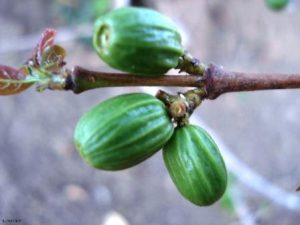
Coffea zanguebariae. Photo: Brian Orford. Source: Flora of Zimbabwe
Part 2 of “trees we rarely see”. And in to Rubiaceae with Coffea zanguebariae (the large-leaved wild coffee). This particular specimen was collected by Kim and comes from the north of Zimbabwe by the Sapi River mouth. The fruit has two pyrenes per fruit and as the common name suggests has relatively large leaves. Shortly after, we came across another lowveld species of coffee. This was Coffea racemosa (Wild coffee), which has shiny leaves with an undulate margin. Tom mentioned how, like many other low altitude trees it flowers spectacularly but briefly; the flowers are pink and occur when the tree has no leaves.
Amblygonocarpus andongensis (Scotsman’s rattle) is a tree we have actually seen – in my case, only at its famous Victoria Falls railway station site. It occurs in the N and W of Zimbabwe on Kalahari sand and also in suitable sands in the SE. In Mozambique it occurs in coastal forest. The leaves are large and 2-pinnate (it is a legume from the subfamily Mimosoideae) and lack glands completely. The fruit is brown and 4-angled, making it almost square in cross-section. Somebody with sharp eyes spotted a fruit on the tree in the Gardens.
On to the genus Erythrophleum, the ordeal trees. The first one seen was Erythrophleum africanum; primarily it is a Kalahari sand species but it occurs in other places and in other sandy soils. The specimen from the Gardens is definitely a different form, but probably not distinct enough to be recognized as a separate species. The leaves are 2-pinnate with alternate leaflets and it belongs to the subfamily Caesalpinioideae of the Leguminosae. The Forest ordeal tree, Erythrophleum suaveolens, is a much rarer species occurring in the Haroni-Rusitu and in the Burma Valley. Generally it is a rainforest tree but it does occur in Brachystegia woodland.

Diospyros squarrosa. Photo: Mark Hyde. Source: Flora of Zimbabwe
Three species of Diospyros were seen. Diospyros squarrosa, the Rigid-star berry, is a local species of generally low to medium altitudes. Tom mentioned it was not tied to any particular ecology. It may be seen in the Zambezi valley, but also occurs at low altitudes in the SE. Diospyros usambarensis (Dye Diospyros) is a rare species of the SE lowveld. The most characteristic feature is the exceptionally glossy leaves. According to Coates Palgrave the common name arises because a black dye is obtainable from the roots. Thirdly, we were shown Diospyros hoyleana. In Zimbabwe, this rare species has been found in the Haroni-Rusitu only.
A most interesting session was had with the genus Rinorea. The family is Violaceae, better known to those from Europe for the plants known as violets – delicate herbs with purple or white flowers with a long spur.
There are 5 species in Zimbabwe; all are rather rare shrubs or small trees of the E and SE, and we were privileged to see three of them. The first one seen was Rinorea ilicifolia (Holly-leaves Rinorea). I was amazed to see how like a Euphorbiaceae it is with its 3-lobed fruit and alternate leaves; indeed the some¬what toothed leaves are said to resemble Drypetes natalensis, which does belong to the Euphorbiaceae. The specific name means with leaves like a holly (Ilex). The leaves are larger than other species of the genus. It is very rare in Zimbabwe and occurs in the Haroni-Rusitu forest.
Rinorea ferruginea (Hairy-leaved Rinorea) is more common; for example it is quite frequent in the Chirinda Forest. The leaves are narrowly elliptic or oblanceolate and are less prickly than Rinorea ilicifolia. Finally, we saw Rinorea convallarioides, once again occurring at Haroni-Rusitu and in the Chirinda forest. This is a species with smaller leaves.
Finally, Cordia grandicalyx. Like Ptaeroxylon obliquum, this tree occurs in the SE lowveld and also in the Matopos. The leaves are rough, but not as rough as the really scabrid Cordia monoica, and are almost circular in shape. The calyx as the name suggests is large and according to Coates Palgrave is expanded and frilled and also sometimes recurved. The family is Boraginaceae, which is mainly herbaceous, but also includes in our area the woody genera Cordia and Ehretia and indeed some authorities separate off the woody species into separate families.
Once again, a big thank you to Tom for giving up his spare time for the Society.
-Mark Hyde
DROSERA, THE SUNDEWS
The Drosera spp., commonly known as Sundews, appears to be little-encountered or remarked upon in Tree Life. Since issue No. 180 (February 1995) there has been only a single mention of this fascinating genus of plants – “Higher up the slope in the wet soaks the pinky-white lobes of the insectivorous Drosera sp. lay flat waiting for a fly or similar prey to visit.” BUCHWA – 12 AUGUST 1996, In search of Oreobambos buchwaldii, October 1996 No. 200
So, I ask, is this genus that uncommon or are our intrepid Tree Society foot-stampers venturing only into dry territory, the above notwithstanding? It’s clearly time to awaken members to this group of wonderful and overlooked plants.
The Botanical Garden
Queen of the marsh, imperial Drosera treads
Rush-fringed banks, and moss-embroider’d beds;
Redundant folds of glossy silk surrounds
Her slender waist, and trail upon the ground;
Five sister-nymphs collect with graceful ease,
Or spread the floating purple to the breeze;
And five fair youths with duteous love comply
With each soft mandate of her moving eye.
Dr. Erasmus Darwin, grandfather of Charles Darwin, publ. 1791
Drosera belongs in the Droseraceae family, the second largest carnivorous genus after Utricularia family Lentibulariaceae. Three other genera comprise the family: Drosophyllum (Portugal, Spain and Morocco), Dionaea (East Coast North America – the Carolinas), and Aldrovanda (Europe, Japan and Asia, northern Australia and Africa).
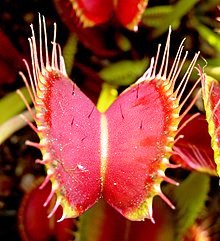
Dionaea muscipula. Photo: Wikipedia
All these are carnivorous (or insectivorous) plants and most people are familiar with the Venus flytrap – Dionaea muscipula. Dionaea, Aldrovanda and Drosophyllum are monotypic, the latter being restricted to small areas. Aldrovanda is an attractive floating plant called the waterwheel plant and is similar to the Venus flytrap in that it has traps which act in much the same way. The closest it comes to Zimbabwe is the Linyanti/Okavango in Botswana, though it has also been recorded in Mozambique (Flora Zambesiaca 4).
Drosera are distributed worldwide; with representatives on all continents barring Antarctica (& Greenland?) there are some 125 species, with many hybrids and sub¬species and varieties. Australian’s are lucky in having the bulk of species – over half! This is not to say that Drosera is averse to snow since Drosera arcturi for instance occurs on the New Zealand Alps. Before describing the leaves of the sundews I’ll deal with their basic growth forms. Above ground: keys divide them into either caulescent or acaulescent. The acaulescent species have no stem or at most a very short unnoticeable one and thus form a basal rosette of leaves surrounding the growth point and sit practically on the ground – in Zimbabwe Drosera dielsiana, Drosera burkeana (and sometimes Drosera madagascariensis). Drosera madagascariensis, Drosera affinis and Drosera indica, the stemmed – caulescent – forms have longer petioles and alternate leaves, tending from elliptic, obovate or spathulate to linear. These can reach heights of ½ m in the annual D. indica.
Elsewhere in the world they range from the rather minute Australian Drosera parvula, a pygmy rosulate species which has leaves a mere 2 mm in diameter, making the whole plant only c.1cm in diameter, to others (caulescent) which attain heights of up to 1½ m. Other forms exist though they are of less relevance to us in Zimbabwe. Drosera peltata ssp. auriculata is also an erect plant, occasionally reaching 70 cm, but with branches near the top – the Aboriginal name is Errienellam, meaning ‘entrapping hair’. Its peltate-shaped leaves have a very pleasing shape. Even taller (1m) and of appearance like a normal herbaceous plant is the Giant Sundew, Drosera gigantea, also of Australia, it branches frequently. Others scramble along the ground, the Modest Rainbow (Drosera modesta, Aust.) with the largest leaf of each group of three being used for support by attachment to plants and other objects.
These last three species are also described as tuberous and this brings us to another difference used in subgeneric and sectional classification. It can all be rather confusing and the finer points of classification can be ignored by us since our sundews are non-tuberous. True roots are suppressed in the genus and the pseudo-roots are developed to various degrees. From Worcester in the Cape comes Drosera regia; only known from the type locality it is unique in that its root is long and woody and the stem too is woody. Since it didn’t properly fit into previous subgenera and “none of the other known species of Drosera is closely related to it”, it has the distinction of having had a new subg. Regiae proposed for it. Interestingly enough, Seine & Barthlott describe it as suffruticose, meaning (I suppose) it has a permanent woody base but not, I take it, that it’s a suffrutex? (See Tree Life No. 227 for suffrutex ‘trees’).
The ‘business end’ of the sundews is the leaf. As mentioned above, leaf shape varies from orbicular to spathulate to linear, with petioles too of various lengths, from apetiolate in Drosera dielsiana (according to Flora of Southern Africa Vol. 13 but not FZ 4! – oh dear) to 2-5 times the length of the lamina in Drosera affinis. However, it is likely that such characters can vary in different regions according to climatic and other conditions, much like some species varying from rosulate to caulescent depending of availability of light, season, etc.
Leaf of D. burkeana – from Flora Zambesiaca 4. Note suborbicular, obovate shape Drosera comes from the Greek drosos – dew – and this is supposed to refer to the droplets of dew glistening on the leaves in the early morning. Perhaps the sticky-tipped tentacles help dew precipitate but I think the drops of mucilage itself make them look dew-covered all the time; to me this is a more logical explanation.
What so grabbed Darwin’s imagination and what no doubt stimulated him to write Insectivorous Plants (1876), was the plants awareness of animal matter and the leaf’s ability to respond. Being relatively small in the carnivorous world sundews usually catch insects.
To achieve this end the upper surface of each leaf is covered with prominent, gland-tipped, green to reddish tentacles, which excrete a clear, sticky fluid – the mucilage. There are two types of tentacles or emergences – short digestive glands and stalked mucilage glands. The stalks of these tentacles are basically similar but the glandular heads vary, there being 5 types – the differences are useful for subgeneric and sectional separation . Some of these four interests us, referring to local species, but it will suffice to say they are restricted to the leaf margins; the 5th is a bristle lacking glandular tissue found only on Drosera rosulata (Aust.). Leaves also have 13 trichome-types of various constructions (basically hairs) which may be glandular or not and from what I understand are possibly the basic forms of the digestive glands; glandular trichomes tend to be shorter and non-glandular longer. They are found on the petiole and the lamina.
These irritable organs are capable of detecting prey movement or even the presence of immobile organic matter (through chemical means), and bend inwards pressing the meal down onto the surface of the blade. Most, if not all leaves fold over or roll up the insect, being more responsive to continued motion.
Digestive glands have similar architecture to mucilage glands but secrete digestive peptonising enzymes to break down the prey, thereafter absorbing nitrogenous matter, potash, lime and phosphorus and mineral salts. Because of this ability plants are able to grow in bogs, swamps and the like, areas that are often acidic and short on such necessary growth elements. Plants that catch a lot of insects therefore tend to be stronger, grow better and produce more flowers and more numerous seeds.
-Ian Riddell To be continued
UMKAUZAAN
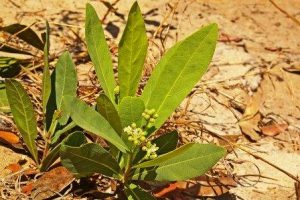
Dichapetalum cymosum. Photo: Meg Coates Palgrave. Source: Flora of Zimbabwe
“Umkauzaan” said my guide, pointing to a ground hugging plant during a visit to Hwange National Park. I illegally alighted from the game viewing vehicle to pick a leaf as it was too far down to get at it any other way and besides how can one botanize without using one’s tactile senses! The lateral (secondary) veins were looped before reaching the leaf margin and the leaf blade felt somewhat leathery with a similar colour both top and bottom. This is a characteristic of a plant that I had got to know as a veterinary student by its Afrikaans common name of gifblaar, just as my Zimbabwean guide knew it by its Ndebele name. Much to my annoyance I had to return home to consult my university notes before the botanical name – Dichapetalum cymosum that was such an important species of my toxicology curriculum, came back to mind!
Dichapetalum cymosum can be likened to an underground tree with a deep root system of up to 12 meters enabling it to sprout early in spring before the rains arrive providing a fatal temptation to the unwary! The leaves are alternately arranged. Fine hair-like stipels attach to either side of the petiole but are shed early leaving a minute scar. Young shoots are normally hairy, however if this hairiness persists into maturity then this is associated with a high degree of toxicity.
Gifblaar in Zimbabwe frequents the Gusu sands of the Kalahari and often forms part of a plant community known to farmers as “Poison Veld”. Biomes consisting of indicator trees including Ochna pulchra, Terminalia sericea, Burkea africana (Red Syringa), Acacia erioloba (Camel Thorn), Baikiaea plurijuga (Zambezi teak) and Parinari capensis. This latter plant is also a ground hugging rhizomatous sub-shrub that grows in thicker mats than those of gifblaar but has a typical bicoloured Parinari leaf.
Burtt-Davy recorded the first outbreak of poisoning in 1903. Marloth quotes that the fruits (rarely seen, yellow green drupe the size of a large grape) are eaten by the Ovambo of Northern Namibia with impunity.
The toxic principle in gifblaar is mono-fluoroacetate (MFA) that influences the Kreb cycle resulting in cellular respiration failure of either the heart or the Central Nervous System.
The characteristic loop veined leaves can be found after a thorough examination of the rumenal contents of animals dying of this plant. MPA is used commercially as a highly effective rodenticide (Just imagine that with the aid of a bit of chemical manipulation the mono-flourophosphate added to toothpaste could turn into a killer!). By connecting an underground stem via some latex tubing to a 1 to 2½ % copper sulphate solution stored in a bottle is a cheap, effective and environmentally safe way of destroying the plant.
Poisoning due to gifblaar rarely exhibit any clinical signs. Cattle ingesting lethal amounts usually are found dead especially after drinking water or exercise. I recently attended a lecture by Prof. Kellerman (Principle author of the book “Plant Poisonings and Mycotoxicoses of Livestock in South Africa”) on the poisonous plants of practical importance in Zimbabwe, where he related a story about cattle deaths always occurring on the day that the steam train travelled from Mahalapye (Botswana) to Plumtree. To the farmers it was clearly due to something sinister about the train. It later transpired to be due to the cattle ingesting a plant very similar to gifblaar called gousiekte bush (quick disease), Pachystigma pygmaeum. The excitement caused by the passing train was just too much for their frail and failing hearts to endure. This plant can be distinguished from Dichapetalum cymosum by the oppositely arranged leaves with a large triangular internodular stipules characteristic of plants belonging to the Rubiaceae family.
Deaths due to gousiekte occur 4 to 8 weeks after the plant has been ingested so no leaves are found in the rumenal contents but the heart muscle shows distinct signs of fibrosis particularly to the inner aspects of the myocardial muscles.
Southern Africa is blessed with a very rich diversity of plants and unfortunately about 600 are known to be potentially toxic to livestock. Blending botany, toxicology, natural history and regional history into a rich tapestry of outdoor life surely must amount to one of the great pleasures of living in Africa.
-Karl van Laeren
In Retrospect by Lyn Mullin (Continued)
VISIT TO BERNARD MIZEKI SHRINE
A report in Tree Life No.8 (November 1980) on a visit to the Bernard Mizeki Shrine on 19 October 1980:
This was a joint visit with members of the Natural Resources Board and the Wildlife Society. The day was unusually overcast for October, and there was a faint drizzle until about 9.30 – very welcome as it ensured that the outing – was pleasantly cool for climbing “Pamusoro” and the Lekkerwater Ruins in the afternoon.
The attraction for the Tree Society members was the ‘riverine forest’ in a shallow valley on the side of a granite hill, down which flows a small stream. Dr Penny Grant described how at one time the micro¬climate maintaining the forest was all but destroyed. However, after years of careful management, the forest has recovered.
It is interesting to note that the wild banana, Ensete ventricosum, had disappeared from the site, but returned later, suggesting that the seed of this species has a viability of several years.
Two species of cabbage tree, Cussonia arborea and Cussonia natalensis, were found. It seems seldom that we see any but the former. Three species of lucky-bean tree, Erythrina abyssinica, Erythrina latissima, and Erythrina lysistemon, in the area were an interesting find, though it is possible that the Erythrina lysistemon was introduced.
Crassocephalum mannii (canary-creeper tree) was new to many. It is an understorey shrub, and was in full flower and fruit. The flowers are said to smell like dirty, sweaty socks!
PRIVATE TRAVELS
An unauthored note in Tree Life No 11 February 1981):
Recently I have paid visits to two interesting tree sites, one near Pretoria and the other in Zimbabwe. Interested members who may be visiting Pretoria should visit the “Wonderboom”. Apparently this “tree” does not show the typical growth form of the species (Ficus salicifolia – still called Ficus pretoriae on the notice board at the site).
Wherever the branches of the original tree drooped and touched the ground they rooted, and eventually formed new trees. There are now at least 3 distinct generations from the original tree – whose age is calculated at about 1 000 years – covering a vast area. We were told by the information board that, in the past, 1100 men have slept at one time in the shade of this remarkable phenomenon. The trees were in fruit (early December), and large numbers of birds, both frugivorous and insectivorous species, were in attendance.
The Zimbabwean tree site was the Raffia palm grove near Sipolilo. Here, near the northern end of the Great Dyke, in an ever-damp seepage area, is an 80-acre [32.4 ha] protected area containing a relic population of Raphia farinifera. With the Dyke rising behind, almost devoid of trees and shrubs, the area truly bears the air of a primeval forest. The largest trees are of considerable stature – the leaves alone may reach 18 m. Many were in fruit, and the shiny, cone-like seeds littered the ground. This species unfortunately displays the habit of dying after setting fruit, so trees are comparatively short-lived. Unique furniture may be constructed from the leaves of these plants, but, of course, the Sipolilo palms are protected, and there¬fore, we hope, safe from exploitation for the time being.
(To be continued)
PLEASE collect seeds for two members.
Ann Bianchi needs seeds of any indigenous species &
Anthon Ellert needs seeds of any of the Commiphora species. Pack the seeds into separate paper packets remembering to label them with the plants name, date, and location where collected.
If they are left with any committee member the packets will be forwarded to Ann or Anthon.
ANDY MACNAUGHTAN CHAIRMAN


